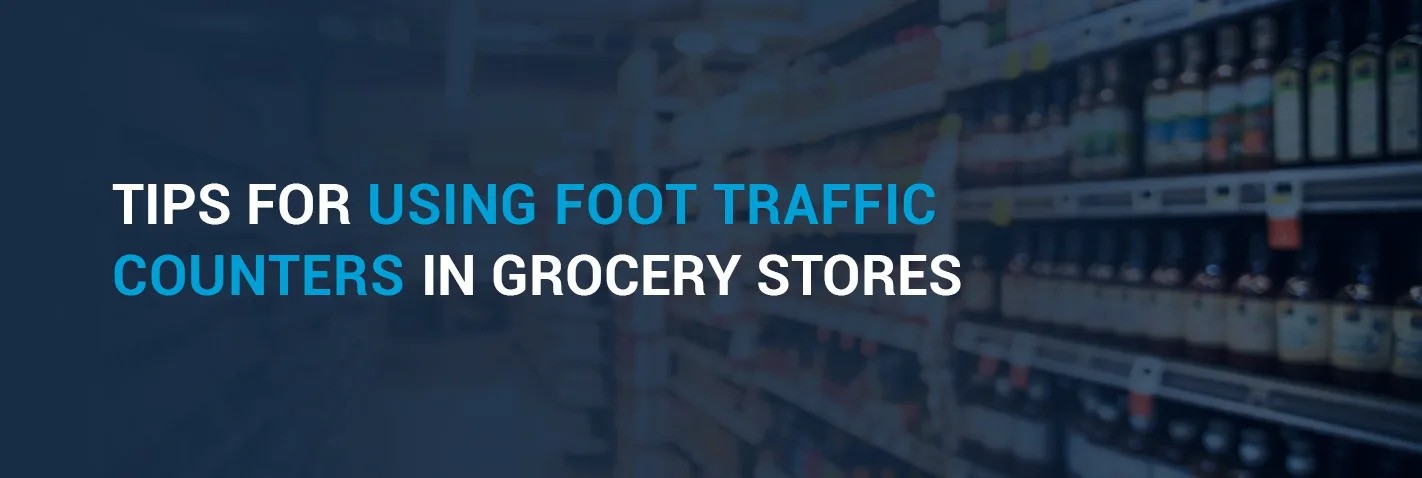

Table of Contents
Grocery stores have been forced to make rapid operational changes to meet local and federal guidelines. While these guidelines are in place to protect the health of employees and customers, their restrictive nature brings up new challenges for grocery store owners.
Social distancing is one of the more difficult guidelines for grocery stores to follow. In the case of the novel coronavirus, grocery stores need to maintain 6 feet of distance between customers and limit the number of people allowed in the store at one time.
Foot traffic counting systems have been offering grocery store owners a way to optimize staffing, scheduling and queuing. They also offer a simple solution to help stores operate within coronavirus-related social distancing measures. In this guide, we’ll discuss how to use a grocery store customer counter to keep your store compliant with social distancing policies and procedures
Retail and food stores must first determine what guidelines they should be following. Two federal agencies are spearheading the new guidelines: the Food and Drug Administration (FDA) and the Centers for Disease Control and Prevention (CDC). The FDA is primarily concerned with the safety of products and employees involved with food preparation, while the CDC is providing guidelines for employers as a whole.
Grocery store owners and managers should become familiar with all major CDC guidelines and apply FDA guidelines where appropriate, such as at a deli counter. The National Grocers Association has compiled a list of practices to help grocery stores meet CDC guidelines, including:
These guidelines are not completely comprehensive, and there are many more details available on the CDC website. However, the list above covers the essential practices grocery stores must implement.
Some states and local governments are putting forth their own grocery store social distancing guidelines, which are more specific and stringent than federal ones. Massachusetts, for example, issued an order in April 2020 that limits grocery store customers and staff to 40% of the building’s maximum permitted occupancy level.
Additionally, the United Food and Commercial Workers International (UFCW) union is petitioning the CDC to restrict store occupancy to between 20% and 30% of the building’s full capacity.
Complying with coronavirus-related regulations is a challenge. The larger a grocery store is, the more difficult it is to keep track of comings and goings in the building. A grocery store people counting system is an easy, intuitive way to make sure your business does not exceed grocery store capacity limits while social distancing guidelines are in place. Let’s take a look at five key ways foot traffic counters can benefit your store:
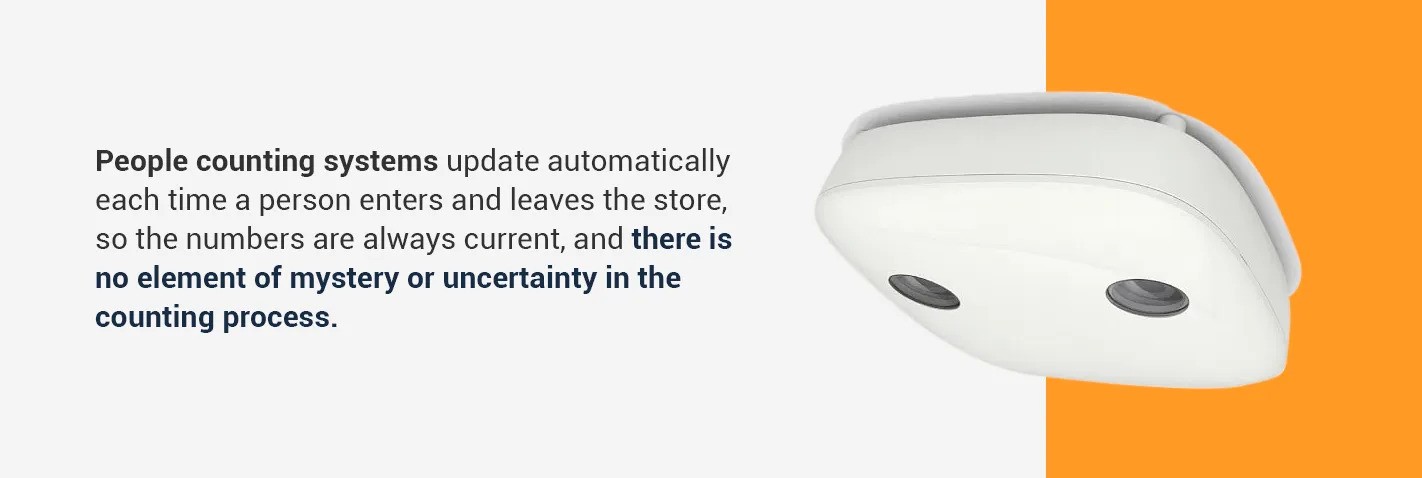
Counting heads in a grocery store can quickly become an overwhelming prospect if you try to do it manually. If you have multiple entrances, you will need to shut all but one down because it’s impossible for two employees doing two different counts at two different doors to sync their counts up without a real-time system in place.
People counting systems update automatically each time a person enters and leaves the store, so the numbers are always current, and there is no element of mystery or uncertainty in the counting process.
Promoting social distancing may mean rearranging some parts of the store to prevent people from clustering together. People counters, especially those with directional capabilities that indicate whether customers are coming in or going out, can help managers make decisions about temporary layout changes.
For example, if the customer counter shows high traffic and employees notice that a good deal of that traffic ends up clustering around one particular area, you can investigate possible reasons why. Is the display overly large and causing a bottleneck due to people trying to navigate in opposite directions around it? Is it located near a checkout line, causing people who want the item to get too close to customers waiting in line? Traffic monitors can provide excellent opportunities for innovation in this area.
Knowing when traffic peaks occur is important because it allows management to adjust procedures to increase safety. Cleaning routines are a good example. A store should have robust cleaning measures in place at all times, but a spike in traffic provides a compelling reason to add extra cleaning duties into employee schedules. However, you don’t want to have employees spending too much time cleaning when it’s not necessary.
With a foot traffic counter, management can set thresholds for the number of customers after which an extra cleaning needs to take place. For example, a store may have implemented a policy of wiping down freezer door handles every hour, assuming a customer turnover of 100 per hour. To better protect everyone’s safety, management may decide that if customers exceed 150 per hour, cleaning needs to happen every 30 minutes. A customer counting system makes this type of adjustment possible.
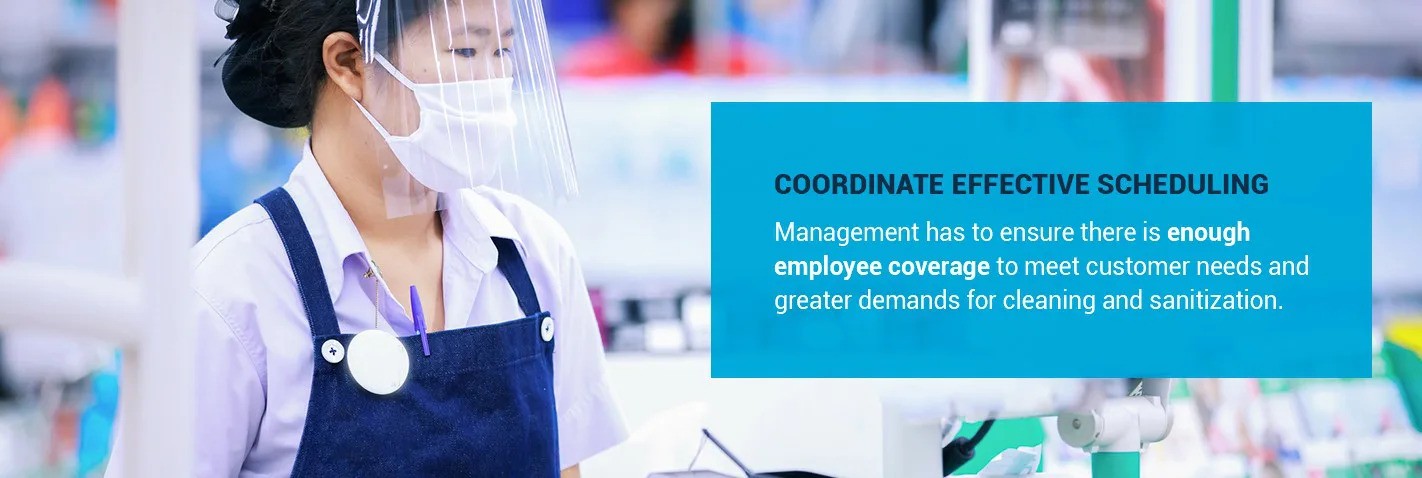
Scheduling employees is always one of the challenges of operating a successful grocery store. Management has to ensure there is enough coverage to meet customer needs and greater demands for cleaning and sanitization. On the other hand, paying more employees than necessary is never a good business practice from a financial perspective.
Under normal circumstances, most grocers quickly pin down when traffic is highest and lowest, and the approximate buying habits of their customer base. There has been an upended in customer habits significantly, from when they come into the store to the amount they spend. For example, even though foot traffic in stores is down, shoppers are spending 15% to 20% more on groceries.
Foot traffic counters provide information that allows management to make the most efficient staffing decisions under new and changing circumstances, with much greater accuracy than relying on general observations.
From the customer’s point of view, the coronavirus outbreak has made grocery shopping a far less pleasant experience. Having to follow the 6-foot rule means many grocery stores are having to stop customers at the door and have them form a line to wait until the store is under its modified capacity. Even then, customers at stores that aren’t well-prepared are facing long lines due to understaffing.
Grocery store people counting systems offer a customer-facing dashboard that shows the current capacity in terms of the upper occupancy limit and the percentage of capacity the store is at currently. When they can see traffic changes in real-time, customers tend to feel less stressed and uncertain while waiting to enter a store. Additionally, stores with people counters have the tools to staff appropriately. That means customers can feel safe knowing the store has enough staff to clean properly as well as keep checkout line lengths from becoming frustratingly long.
Leveraging a foot traffic counter to provide a better customer experience is key to retaining customers in a time where many are willing to change retailers as a response to a poor experience.
It takes planning to stay prepared, so consider these tips for staying compliant:
Although the CDC and FDA are providing guidelines on a national level, the restrictions on grocery stores may be more stringent at a local level. Grocery store owners and managers need to stay up-to-date with guidelines that change frequently and be aware of what practices are simply guidelines as opposed to formal orders with potential legal consequences.
Sign up for alerts from your state and local health departments to ensure your store can pivot to new policies or procedures as quickly as possible when necessary.
As employees are the ones who will be carrying out social distancing and prevention measures, it’s essential to provide thorough training on the store’s new policies. Education efforts should be done in person, where possible, and duplicated in written form to ensure better retention. Employees need to know about:
Consider compiling a list of resources for employees, such as information on hand-washing and new cleaning policies, and place it in a high-visibility area. Ultimately, management is responsible for ensuring employees understand and follow the new guidelines.
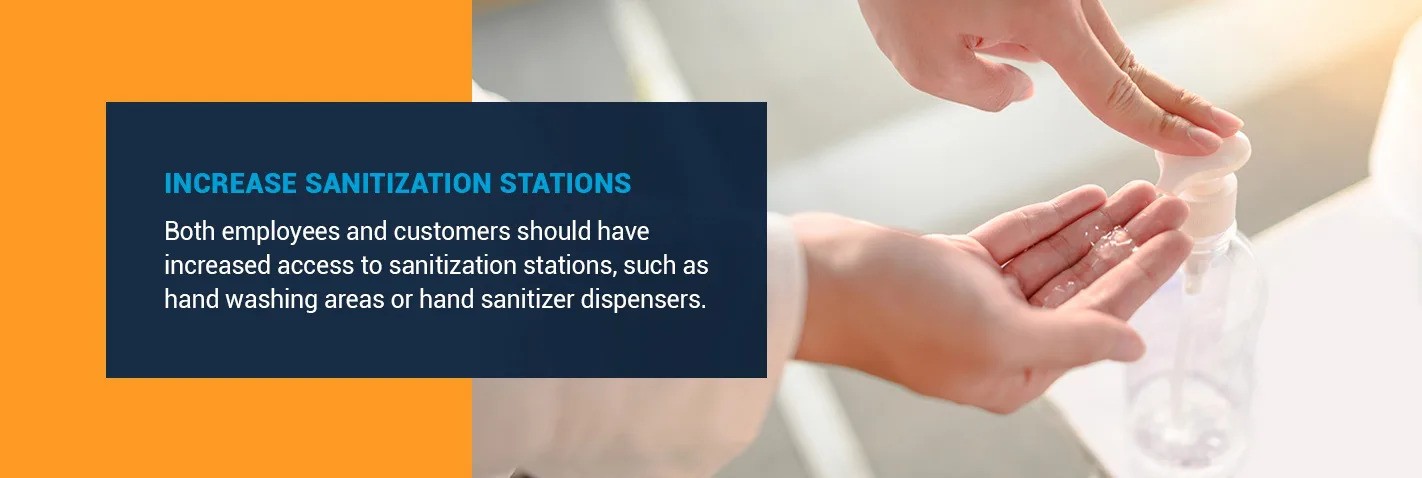
One aspect of social distancing is making an effort to reduce the transfer of the virus from person to person through increased sanitation. Both employees and customers should have increased access to sanitization stations, such as hand washing areas or hand sanitizer dispensers.
It’s a good idea to place these stations at entrances, as well as near high-traffic and high-touch areas. A people counting system with dwell technology can help you find out where people spend more idle time, allowing you to pinpoint the best locations for additional stations.
One of the critical steps in following CDC cleaning guidelines is to increase the frequency of cleaning and ensure employees are using products approved by the Environmental Protection Agency (EPA). Stores should undergo a thorough cleaning at least once every 24 hours, and disinfecting procedures should see these surfaces sanitized more frequently:
The CDC’s framework for cleaning and sanitizing is based on three practices:
Personal protective equipment is still hard to come by, even for essential businesses. The National Grocers Association suggests requesting face masks from the United States Department of Agriculture (USDA) through their online form as one way to increase the PPE available to employees.

Knowing the number of people in a grocery store is no longer an option in many places. To limit grocery store capacity levels, you first need to know how many people are inside the building. Installing a people counter is quick, easy and provides a simple way to keep tabs on store occupancy without assigning employees to do potentially inaccurate headcounts.
One of the challenges with social distancing in grocery stores is the two-way nature of aisles. When two people are headed down the same aisle in opposite directions, there’s little opportunity to avoid a direct exchange of droplets. Many large grocery chains are implementing one-way aisles as well as designating in-only and out-only doors to help prevent customers from coming into close contact with each other.
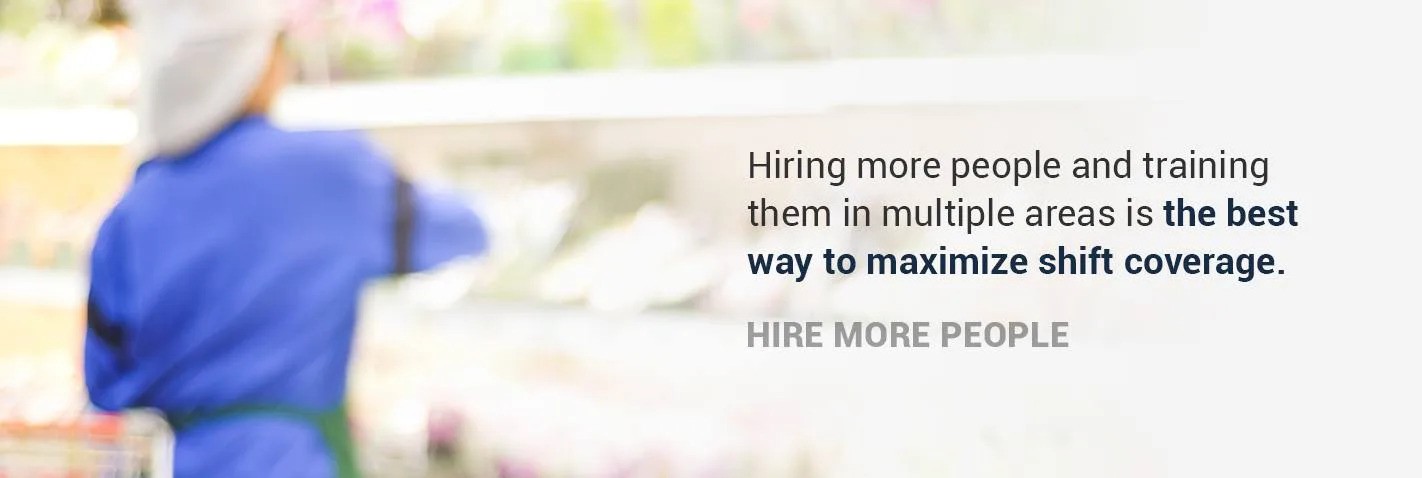
The extra burden of increased cleaning practices takes employees away from time on the floor and at the cash register. Hiring more people and training them in multiple areas is the best way to maximize shift coverage. This helps ensure swift movement of checkout lines as well as the proper execution of new cleaning policies.
Grocery stores have a responsibility to help customers implement social distancing. In addition to using a foot traffic counter to maintain safe occupancy levels, stores can provide visual reminders via various types of signage. Examples include:
A little bit of prompting can go a long way in promoting social distancing in your store.
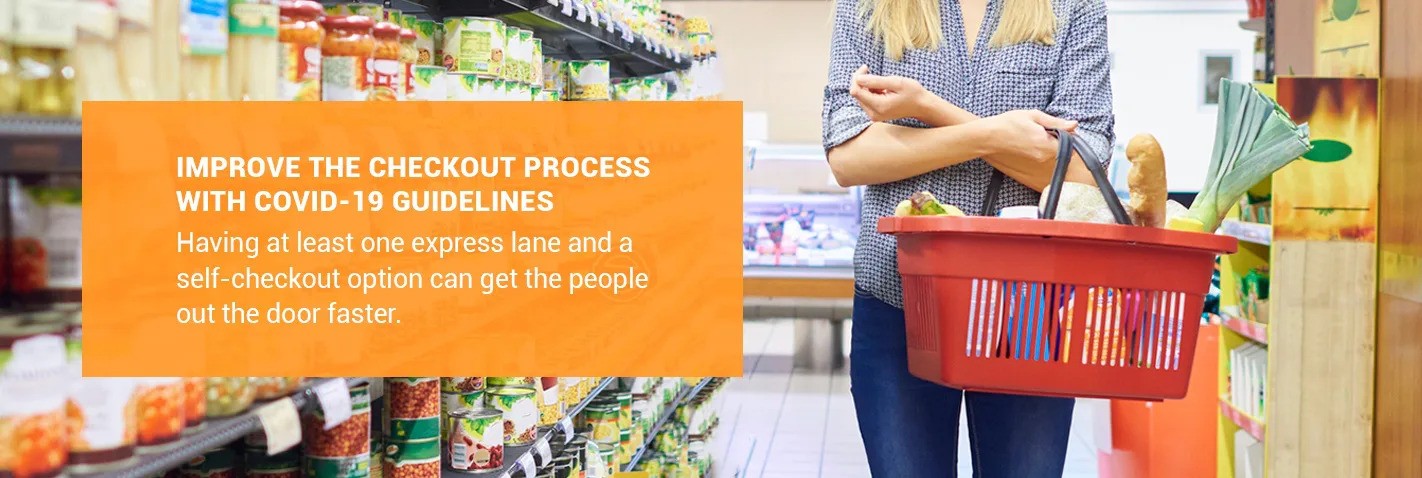
The best way to ensure customers remain happy during the checkout process is to provide adequate staffing and multiple options. For example, customers who only have a basket of items don’t want to wait behind people stocking up with a full cart, so having at least one express lane and a self-checkout option can get these people out the door faster.
Be sure to give your employees the tools needed to succeed within new guidelines. Workers who have enough time and adequate supplies to adhere to cleaning schedules are more likely to do so effectively. Likewise, employees who are given the right PPE are more likely to wear it. Ensure you’re getting the right scheduling coverage and supplies. It shows you care and facilitates better adherence.
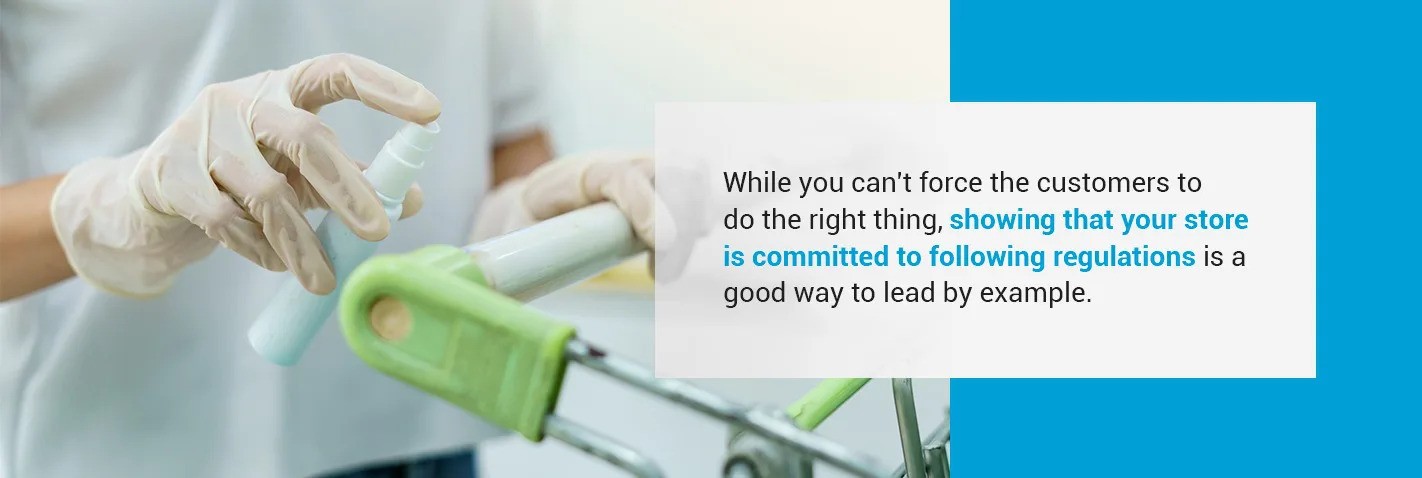
Customers are often unpredictable and sometimes resistant to new guidelines. While you can’t force them to do the right thing, showing that your store is committed to following regulations is a good way to lead by example. When customers see employees wearing PPE and cleaning regularly, combined with high-visibility signage and even auditory reminders of policies in place, they are more likely to comply with new grocery store social distancing guidelines.
There are four important distinctions to make when discussing how people counters work:
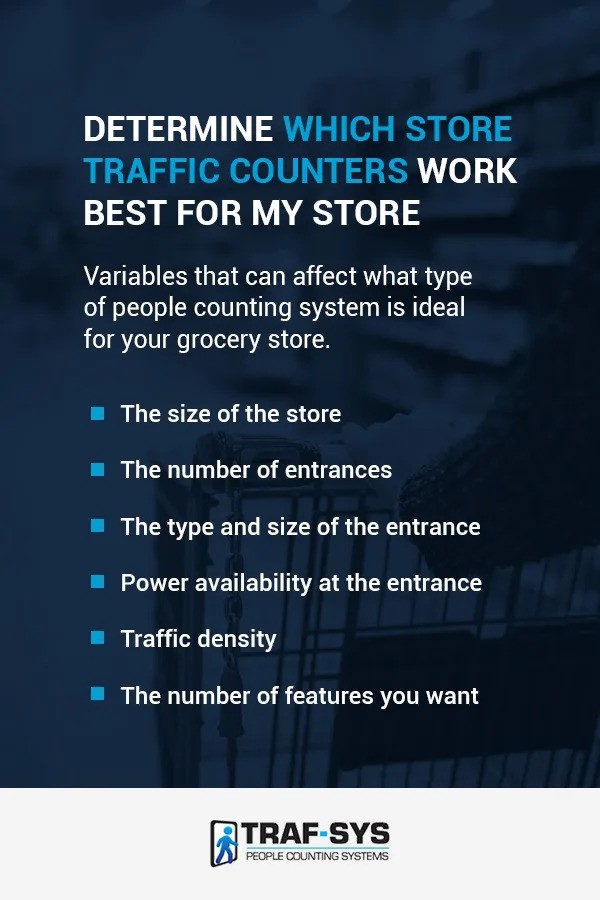
There are several variables that can affect what type of people counting system is ideal for your grocery store. They include:
The majority of major grocery chains are changing the industry with the use of foot traffic counters. The Aldi customer counter and Giant grocery store foot traffic counter, for example, are allowing these stores to maintain accurate customer counts for their new limits. Aldi uses their system to limit customers to around five per 1,000 square feet, while Giant Food stores use theirs to reduce capacity to 20%.
The novel coronavirus has already changed the way grocery stores do business and serve their customers, and there is no telling whether those changes will be permanent. As social distancing guidelines continue to evolve in response to new data, it’s a good idea to stay prepared for even further restricted occupancy with a people counting system.
A grocery store foot traffic counter will enable your store to meet stringent guidelines, and it will act as a data collection tool that can streamline the way you staff and provide insight on customer behavior. Even after the coronavirus crisis has passed, a grocery store people counting system will continue to provide value to your business.
Traf-Sys offers multiple people counting sensors and systems that fit the needs of your store and budget. Our basic systems offer everything you need to comply with occupancy requirements, while others offer an astonishing level of detail, such as being able to distinguish between children and adults for greater analytic insight. No matter what your needs are, Traf-Sys is ready to help.
Fill out our online form to get a quote within one business day, and start on the road to implementing full social distancing requirements.